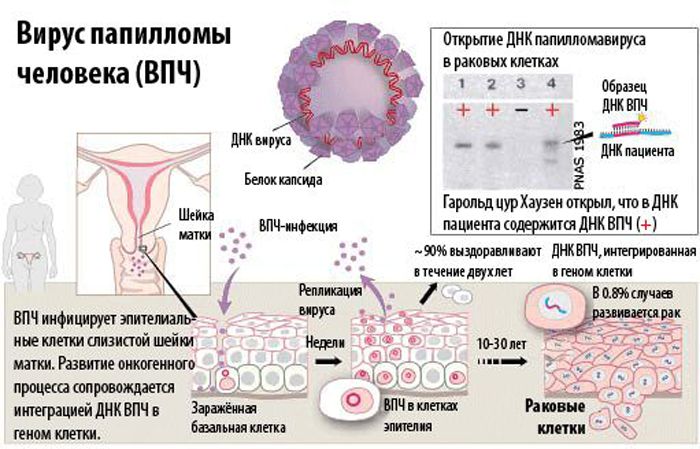Papillomavirus is a lesion of the body, in which the development of not only genital warts, but also warts that occur in intimate areas occurs.
The papilloma virus may not make itself felt for a long time, and often intimate warts are found during an accidental gynecological examination.

It is important to diagnose the disease in time in order to undergo a course of treatment in a timely manner, and to prevent the onset of a malignant process. Individual strains can provoke the occurrence of oncological processes in the body.
Содержание:
- 1 Features of the development of the disease
- 2 Main types of HPV
- 3 Symptoms of papillomatosis
- 4 How HPV infection occurs
- 5 Provoking factors
- 6 Factors that can trigger the development of cancer
- 7 HPV during pregnancy
- 8 Cervical cancer
- 9 How to treat HPV
- 10 What are the possible complications
- 11 Vaccination and prevention
- 12 Treatment prognosis and recommendations
Features of the development of the disease
Viruses themselves are microparticles that consist of a genome and a protein. They are not able to divide in any way, so they need cells from another organism to reproduce.
When the papilloma virus enters the body, it begins to produce certain enzymes that allow it to penetrate into the basal skin cells. As long as the genetic information of the virus has not invaded the nucleus of a human cell, there are no symptoms. But as soon as this happens, a healthy cell begins to change, and not only at the structural level, the genetic code that is responsible for cell growth also changes.
As a result of this “reprogramming”, cells begin to actively and uncontrollably divide, which manifests itself on the surface of the skin in the form of skin growths that do not differ in color from the skin. Some strains of the virus divide very quickly, and they do not even have time to mature, and this leads to the formation of a colony of atypical cells.
Main types of HPV
The main classification of the virus is based on:
- specific;
- degree of oncogenicity.
According to the degree of oncogenicity, viruses are divided into three types:
- Low level. This group of viruses does not provoke the development of oncological diseases, however, HPV 51 can, subject to the presence of provoking factors, cause malignant processes. This group includes HPV 3,6,13,34,42.
- Average level. These are types 52 and 56, which mainly affect the epithelium of the cervix, and under favorable conditions can provoke oncology.
- High level. These are 16,18, 31 types . These types of virus in the genome have a special section that synthesizes E7 – a protein that transforms healthy cells into atypical ones.

These are the main types of the papilloma virus, but there are also others that, although they affect the body of a woman much less often, cause generalized verrucosis – multiple warts covering any part of the body.
Types 6 and 11 can provoke giant warts, which are most often diagnosed in the vulva. They grow very quickly and affect both the surface and inner layers of tissues.
Symptoms of papillomatosis
In the female half of humanity, the papilloma virus has the following clinical picture:
- Genital warts , look like formations with a wide base and jagged edges. As a rule, these formations are not accompanied by any symptoms, although in some cases itching in the genitals during urination and some uncomfortable sensations during intimacy are possible. Genital warts can appear not only on the genitals , but also in the anus. As for the cervix, the formations are localized mainly in its canal.
- Flat condyloma of the cervix is the most dangerous manifestation of a viral infection, which means that the virus has been present in the body for a long time and all this time provokes cellular changes in the epithelium of the cervix.
- Uterine cervix dysplasia is a precancerous condition that is provoked by highly oncogenic viruses. This ailment cannot be diagnosed during a gynecological examination; in this case, histological and cytological studies are necessary.
- Oncology of the cervical region – provoked by the 16th and 18th type of viruses.
In addition, women may experience:
- Plantar wart – occurs in the area of \u200b\u200bstrong squeezing of the skin with shoes. Accompanied by painful sensations, and cause discomfort when walking. These are solid formations of a benign nature.
- Keratopapilloma. It can be observed on the face, in the armpits and neck. The color of the neoplasm can be flesh, brown or burgundy.
- Fibropapilloma is a nodular formation that protrudes above the skin surface. Most often found on the body or on the head. The color and shape of these formations are different.
- A seborrheic wart is a brown growth that can be covered with cracks.
- Flat papilloma – flesh-colored bumps that can disturb a person with itching, redness and inflammation.
How HPV infection occurs
HPV is transmitted from person to person when:
- contact with skin and mucous membranes;
- use of common objects;
- wearing shoes or clothes of an infected person;
- visiting public places – sports showers, saunas, baths.

However, the main route of infection is sexual contact. Infection occurs through any sexual contact – anal, oral, vaginal. In this case, viral agents enter the human body through microscopic damage to the mucous membranes.
Oncogenic viruses in most cases are transmitted precisely during intimacy, therefore, persons who constantly change sexual partners and lead promiscuous sex are in a special risk group.
In addition, the virus can be transmitted from an infected mother to the fetus when the child passes through the genital tract during childbirth. Breastfeeding also does not exclude the transmission of the virus.
Provoking factors
I must say that papillomavirus is not considered a highly contagious virus. For infection to occur, a number of provoking factors are necessary:
- violation of the barrier function of mucous membranes;
- decreased immunity;
- changes in the vaginal and intestinal microflora;
- the presence of sexually transmitted diseases in the body;
- exacerbation of chronic diseases;
- prolonged stressful situations;
- harmful working conditions.
Many people are not even aware that they are carriers of the virus; such a latent period can last up to several decades. In order for the activity of the virus to increase, the following factors are necessary:
- long-term diseases of an infectious nature;
- pregnancy;
- chronic diseases in acute form;
- taking medications that can adversely affect the functioning of the immune system.
Factors that can trigger the development of cancer
In fourth place in the incidence of cancer among women is cervical cancer, we also recommend that you find out which oncogenic type HPV in women . Developed countries provide all women with the opportunity to be screened , which can help detect the disease at an early stage, in 80% of cases this helps prevent the progression of the disease and save a woman from death.
Factors that may affect the development of cervical cancer:
- the first sexual experience was obtained at an early age;
- frequent change of sexual partners;
- smoking;
- significant suppression of the immune system (HIV infection).
HPV during pregnancy
If papillomas began to appear on the body of a pregnant woman, it is extremely dangerous to neglect this. Firstly, the number of neoplasms can increase rapidly, and secondly, the virus can be transmitted to the child during childbirth.
The situation is complicated by the impossibility of conservative treatment, since the drugs that are used to suppress the virus adversely affect the fetus.

The virus has no effect on the intrauterine development of the fetus, but if infected by a child during childbirth, it can lead to laryngeal papillomatosis . This disease can cause respiratory distress and hoarseness. I must say that this disease quickly becomes chronic, while the pathological process spreads further – the bronchi are affected, and in severe cases can cause death from suffocation.
Pregnancy is almost always accompanied by a decrease in immunity, therefore, existing papillomas begin to increase in size, and new formations also appear. They are quite well supplied with blood vessels, and being in the vagina, they can cause severe bleeding during labor. Papillomas can grow so much that they block the reproductive canal, and the woman has to do a caesarean section.
If papillomavirus does not cause external manifestations, then treatment during pregnancy is not prescribed, if genital warts are actively formed and can become an obstacle to normal childbirth, they are removed by laser, cryodestruction or electrocoagulation .
Anaferon or Viferon are prescribed as prophylactic agents for pregnant women. Medications for the treatment of papillomatosis during pregnancy can only be prescribed by a doctor. Self-medication is unacceptable! Most often, drugs are prescribed that cannot cross the placenta, and therefore do not affect the fetus in any way. It can be Immunoflazid, Erebra, Umckalor, Albator.
Cervical cancer
It must be understood that a virus that has entered the body of a woman – 16, 31 or another – is not yet cancer, and it is far from a fact that it can come to this. Moreover, dysplasia is also not cancer, but a precancerous condition. In this case, cancer is preceded by 3 more stages of the disease. Moreover, the first stage is a completely reversible process. If you undergo a course of treatment in a timely manner, then healthy cells will gradually replace atypical ones, and the process will end there. When re-infected with a virus, everything will start anew.
Oncology does not develop from neoplasia of the first two stages. A prerequisite for its development is severe dysplasia. In addition, having detected an oncological lesion of the cervix at stage 1, competent treatment can save up to 80% of women. But all this does not detract from the scale and seriousness of the situation. The human papillomavirus is the most common cause of the development of oncological processes in the uterine cervix.
In the early stages of the disease, symptoms may be absent altogether, or be blurred. Later stages of the disease are accompanied by:
- bleeding;
- unpleasant odor from the intimate area;
- swelling of one leg.

How to treat HPV
The currently available methods of treating the papillomavirus cannot be called perfect, since it is impossible to completely get rid of the virus . However, it is possible to deactivate it, and the effectiveness of therapy is almost 90%.
When choosing therapy, doctors start from the genotype of the virus . Therefore, it is very important to undergo diagnostic tests.
Conservative therapy
Specialists prescribe drugs that significantly strengthen the immune system and destroy virus cells. These could be the following:
- Allokin alpha . This is a drug for intravenous administration, which is prescribed in the presence of a highly oncogenic virus strain.
- Groprinosin. The tablet form of the antiviral agent quickly eliminates the external manifestations of the virus.
- Viferon is available in the form of ointment, spray and suppositories. Eliminates external manifestations and is a drug that is part of the complex treatment of papillomavirus infection.
- Isoprinosine. This drug is used both for the treatment of a viral infection and for prevention. Enhances the effect of Allokin alpha.
In combination with medical treatment, surgical treatment is prescribed.
Surgical treatment
A significant disadvantage of surgical treatment is the high probability of recurrence, which is 50%. Therefore, together with surgical treatment, it is necessary to take medications that reduce the activation of the virus.
The papilloma virus in some cases lends itself to folk remedies, however, their use is advisable only in the initial stages of development. Castor oil , herbal phyto-collections, chicken proteins are used .
What are the possible complications
Complications that HPV can provoke in women are the occurrence of flat warts on the cervix and oncological diseases. The latter provoke strains of types 16 and 18.
Vaccination and prevention
Modern medicine has two HPV vaccines in its arsenal, which protect the body from the most dangerous types of the virus – 16 and 18, in addition, they provide some protection against other rare types that also provoke cancer. These are the vaccines Gardasil and Cervarix . It is preferable to vaccinate before the first sexual contact – at the age of 10-13 years.
In addition, HPV prevention is:
- compliance with hygiene rules;
- treatment of sexually transmitted diseases;
- use of barrier methods of contraception;
- giving up bad habits;
- refusal of casual sexual contacts;
- increased immunity;
- elimination of stressful situations.
Treatment prognosis and recommendations
After 35 years, it is impossible to eliminate the virus of the body, you can only stop the process of cell division. But for this you need to undergo preventive examinations with a doctor, do a PCR analysis and follow the recommendations of a specialist exactly.
Doctors note an alarming trend of women seeking help already in the advanced stages of the disease, provoked by HPV. However, with timely medical intervention, the prognosis is quite favorable.
Knowing the insidiousness of the papilloma virus, every woman should carefully monitor her health, and at the slightest violation, immediately contact a competent specialist. Girls who have not yet had sexual intercourse are recommended to be vaccinated, as this can protect them from the penetration of highly oncogenic strains of the papillomavirus into the body.








Интересная статья, спасибо автору 🙂